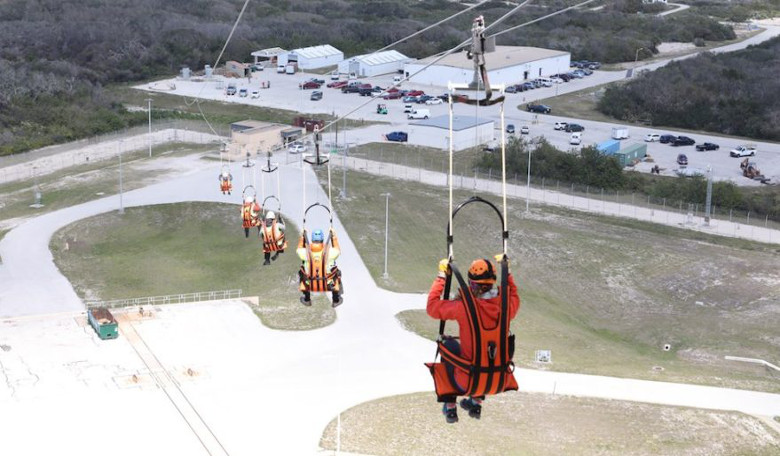Since our first foray beyond the edges of our atmosphere, the need for an Emergency Escape System (EES) to get astronauts off a launch pad in double quick time has become apparent. And what better way to escape from danger than speeding away on a slide-wire system – one that is not too dissimilar to the type of adrenaline-fuelled zip lines found at many tourist attraction sites.
Using this perhaps surprising but very practical method, United Launch Alliance (ULA) have teamed together with Terra-Nova Zipline to provide NASA and commercial astronauts with a safe, new generation escape route known as an Emergency Egress System (EES), that In just 30 seconds, will allow a rider to reach a top speed of 40 mph, should the need arise to get away from the launch pad at speed.
“ULA is absolutely focused on the safety of the crews we will be supporting, and, although we hope to never use it, we are excited to announce the Emergency Egress System is fully operational,” said Gary Wentz, vice president of Human & Commercial Services.
ULA is working with Boeing on their Starliner programme by providing the Atlas V rocket to send up to seven passengers, or a mix of crew and cargo, for missions to a low-Earth orbit. With a goal similar to that of SpaceX’s to recycle rockets, Starliner, Boeings first commercial spacecraft, will be able to be reused up to 10 times with a six-month turnaround time.
Starliner is also being developed in collaboration with NASA's Commercial Crew Program to deliver up to four NASA-sponsored crew members and time-critical scientific research to the International Space Station.
The need for such a system is obvious; when dealing with a flight vehicle fuelled with millions of pounds of hazardous propellant, when things go wrong, they can go catastrophically wrong and do so very fast.
Now, with egress cables situated on level 12 of the Crew Access Tower (CAT), 52 metres above the Space Launch Complex 41 pad deck at Cape Canaveral Air Force Station, crew will be able to evacuate to a landing zone in as little as 53 seconds, say ULA.
And, by allowing up to 20 personnel including ground crew and flight crew to evacuate at once, there will be no standing in line waiting for it to become free.
Boeing and ULA have already demonstrated the EES to willing participants on a zipline spanning Colorado’s Royal Gorge, but soon crew and staff will get the chance to test out the facilities albeit at a training system located north of the CAT for riders to practice on before final training on the operational EES.
“Crew safety is paramount, and the ULA Emergency Egress System hits the mark for an effective yet simple system that is adapted from other commercial applications,” said Chris Ferguson, Boeing director of Starliner Crew and Mission Systems and a former NASA astronaut. “We look forward to spaceflight operations next year knowing that every measure to protect the flight and ground crew has been employed."











